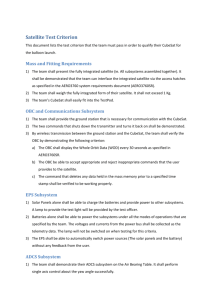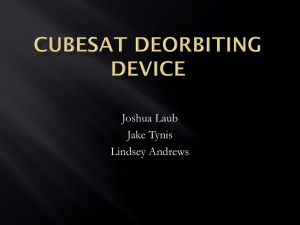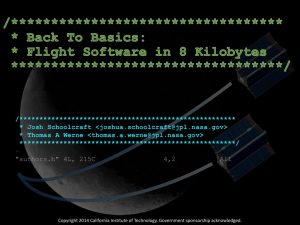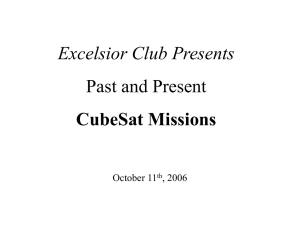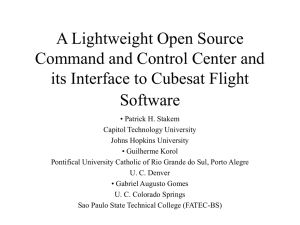University of Tokyo CubeSat Project CRITICAL DESIGN REVIEW
advertisement
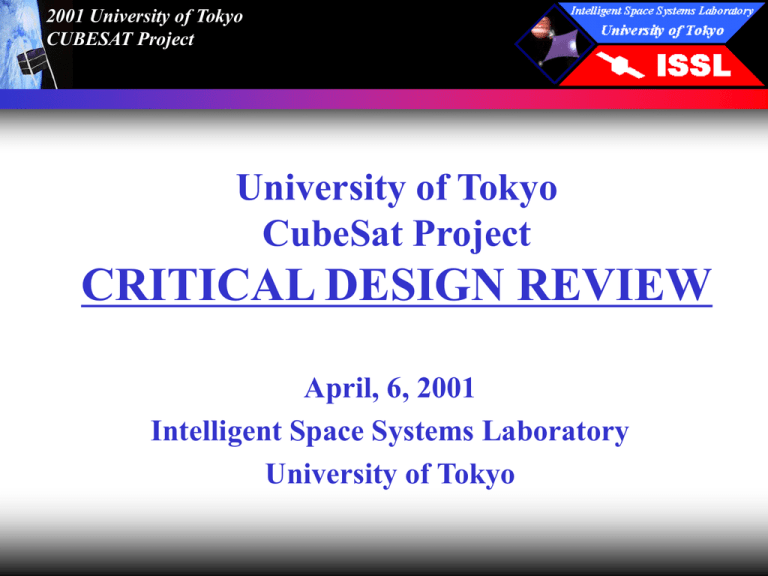
2001 University of Tokyo CUBESAT Project University of Tokyo CubeSat Project CRITICAL DESIGN REVIEW April, 6, 2001 Intelligent Space Systems Laboratory University of Tokyo 2001 University of Tokyo CUBESAT Project ■Contents •Project Overview –CubeSat program, Organization, Management, Schedule •Mission Overview –Design Assumption, Mission Objective, Mission Profile, Success Level •System Design –Design Strategy & Concepts •Subsystem Details –Electronics, Power, Communication, Structure, Environment, Ground Segment •Concerns 2001 University of Tokyo CUBESAT Project Project Overview 2001 University of Tokyo CUBESAT Project ■CubeSat Program ・Proposed in University Space Systems Symposium. (Nov. 1998, Hawaii) ・International educational program to improve students’ skill of space engineering and project management. ・Quick and low cost development policy. ・10cm cubic satellite weighing less than 1kg. 2001 University of Tokyo CUBESAT Project ■Project Constraints ・10cm cubic shape, weight less than 1kg. ・Installed in the carrier called “P-POD”, developed by CalPoly. ・P-POD is to be installed in MPA (Multiple Payload Adopter), developed by One Stop Satellite Solutions Inc. ・Launched by Russian rocket “Dnepr” from Baikonur in November, 2001. ・Orbit 600-800km circular, 60 degree inclination ・HAM band operation 2001 University of Tokyo CUBESAT Project ■CubeSat Developers ・California Polytechnic State U ・Dartmouth College ・Florida Space Institute ・Leland High School ・Montana State University ・Stanford University ・Stellar Innovations ・Taylor University ・Tokyo Institute of Technology ・University of Arizona ・University of Tokyo ・Wilcox High School 2001 University of Tokyo CUBESAT Project ■CubeSat Program Organization Russia Launcher Provider ISC Kosmotras OS2 Mission Organizer OSSS Inc. Stanford U Carrier Provider CalPoly U.S.A. Japan Japan-side Agency Astro Reserch Co. CubeSat Developers U.S.A. 10 Facilities Japan ・U of Tokyo ・Tokyo Inst. of Tech. 2001 University of Tokyo CUBESAT Project ■Payload Configuration MPA Dnepr LV Launch weight 211 t Propellant amyl + heptyl Number of stages 3 LV diameter 3m LV length34m Reliability 0.97 Payload 400kg (800km) 1400kg (600km) (inclination 65deg) Mass < 300kg Isogrid Spaceframe Deploys Payload Satellites Three-axis Stabilization P-POD Deployes 3 CubeSats CubeSat 2001 University of Tokyo CUBESAT Project ■UT’s Project Organization Program Director ・21 active members ・General meeting every 1-2 week(s) ・Subsystem meeting every week Prof. Nakasuka Project Manager Y.Tsuda Electronics Communication Power Structure Environment Ground Seg. Y.Arikawa T.Ito N.Sako N.Miyamura P.Seo S.Ogasawara Y.Tsuda N.Miyamura S.Ishikawa T.Murakami E.Hwan K.Kanairo Y.Kato T.Eishima S.Ukawa S.Ihikawa Y.Kuwata T.Yamamoto S.Ganryu T.Eishima Y.Arikawa S.Ukawa R.Funase S.Hori T.Ito S.Ogasawara N.Sako K.Kanairo K.Muramatsu Y.Tsuda T.Murakami Y.Oda I.Ikeda 2001 University of Tokyo CUBESAT Project ■Development Milestone Development code : XI [sai] (X-factor Investigator) ・Basic functional check XI-I ・Technological demonstration for USSS conference ・Bread board model XI-II ・Validation of all technology to be used Communication test model, Mass model, CDR ・Engineering model XI-III ・Served to the integration & environmental testing ・Flight model & back up model XI-IV,V ・One for flight, the other for operation practice etc. 2001 University of Tokyo CUBESAT Project Mission Overview 2001 University of Tokyo CUBESAT Project ■“XI” Outlook Antenna Latch Mechanism Solar cells are to be attached on whole surface Antenna Flight Pin Hole Camera Hole photo: XI-II (BBM model) 2001 University of Tokyo CUBESAT Project ■Mission Description ■Mission Statement "To acquire the indispensable technology in developing supersmall satellite system" ■Mission ・Gathering the satellite’s health information via beacon signal. ・Command uplink & data downlink. ・Telemetry data broadcasting service. ・On-orbit verification of the commercial-off-the-shelves (COTS) components. ・Imaging experiment as an extended mission. (TBD) ・Sending everyone’s message into space. 2001 University of Tokyo CUBESAT Project ■Success Level (1) ■Project’s Minimum Success --- Acquiring the important technology and knowledge through designing and fabricating the spacecraft. ・Establishing overall work flow of the satellite development project. ・Establishing a methodology of spacecraft design. ・Raising the fabrication technique. ・Conducting several kind of testing and feeding back its results to the design. ・Keeping the project progressing smoothly so as to bring it to be the launchable condition. ■Mission Success --- Receiving signals from the spacecraft. ・Surviving in the actual launch environment. ・Successfully verifying the function of the communication system. ・Gathering house keeping data. 2001 University of Tokyo CUBESAT Project ■Success Level (2) ■Full Success --- Succeeding in uplink & downlink. ・Successfully commanding the spacecraft by uplink. ・Getting downlink data as a reaction to the command uplink. ■Advanced Success --- Successfully verifying the function of the advanced mission components. ・Verifying that sensors planned to be equipped as advanced mission components should work normally. 2001 University of Tokyo CUBESAT Project ■Mission Profile (1) ・Launched by Dnepr from Baikonur in Nov. 2001. ・MPA is put in 600-800km circular orbit with 60 degree inclination. ・MPA deploys some of its payloads & activates P-POD. ・P-POD deploys CubeSats. ・CubeSat starts operation after a certain elapsed time. 2001 University of Tokyo CUBESAT Project ■Mission Profile (2) 1. 2. 3. ■Post Ejection Stand-by ■Nominal Operation ■Telemetry Transmission Main OBC is activated while the other components are off. Antenna is deployed. All components including beacon are activated except telemetry transmission system. This mode occurs as a reply to the uplink command from ground station. 2001 University of Tokyo CUBESAT Project System Design 2001 University of Tokyo CUBESAT Project ■Basic Specifications ●Structure 10cm cubic, 1kg, Aluminum A7075 body ●Main Processor OBC PIC16F877 4MHz(Program memory 8k, RAM 368) Data Recorder EEPROM 32k + 224k ●Communication System Downlink Uplink Beacon 437.490MHz, FSK, AX.25, 1200bps, 600mW 145.835MHz, FSK, AX.25, 1200bps 436.8475MHz, CW, 100mW ●Power System Battery Solar Cells Bus Voltage Manganese type lithium-ion battery, 8 parallel Single crystal silicon, 60 cells 5V ●Attitude Control Passive stabilization using permanent magnet ●Sensors Voltage, Current, Temperature, Area sensor Structure Power PWR5V OBC Main Com1 DC-DC1 TX ROM RX TNC TX TNC TX Analog SW DC-DC2 TLM TLM OBC Com2 DC-DC3 OBC CMD uSW Flight Pin RX TNC RX ACK TLM Charge Circuit CW Gen PWR5V Flight Pin Solar Cell CW Digital Sensors Antenna Latch Important Analog Sensors Analog Sensors Battery 2001 University of Tokyo CUBESAT Project ■Internal Function Design Strategy ■Mother board intervenes intersubsystem signal & power flow. Structure Subsystem Camera Module Electronics Subsystem Data Handling Unit Battery Mother Board Power Subsystem Power Unit Solar Cell Temperature Sensors Communication Subsystem Communication Unit 2001 University of Tokyo CUBESAT Project Structure Subsystem 2001 University of Tokyo CUBESAT Project ■Structure Subsystem 1. a) b) c) d) Body of CUBESAT Assembly Weight and Center Of Mass Material Size 3. Antennae Deployment Mechanism a) Magnetic Plunger b) Folding Method 2. a) b) c) d) Interface Flight Pin External Input/Output Connector Kill Switch 4. Strength Analysis a) Behavior as Cantilever Beam b) Ceiling panel’s vibration c) Load Estimation d) Countermeasure for vibration(Antennae) 2001 University of Tokyo CUBESAT Project ■Body of CUBESAT a) b) c) d) Assembly Weight and Center Of Mass Material Size z y x Center Of Mass 2001 University of Tokyo CUBESAT Project ■Assembly of XI-II +z panel Panels to put up solar array on +y panel The mainstay of XI-II +x panel ■First, Subsystem Boards are attached to Mother Board. ■Then,that module is attached to 4 pillars. ■Finally,Solar Cell panels covered CUBESAT’s surface. 2001 University of Tokyo CUBESAT Project ■Construction of subsystem board Electronic board Power board Communication board Transceiver Main motherboard Battery box I/F board Sub motherboard ■Each subsystem board is attached to Mother Board. ■Battery and I/F connectors are also attached to Mother Board. 2001 University of Tokyo CUBESAT Project ■Center Of mass z y ■The difference of geometric center between center of mass is 7.8mm (within 20mm) ■Total mass is 990g Center Of Mass(within 1kg) x 2001 University of Tokyo CUBESAT Project ■Material USE Main Structure PCB Battery Solar Cell IC PRODUCT A7075 Glass Epoxy Li-ion Rechargeable battery Si-Cell Plastic Packaged Wiring Teflon coated Bolt,Nut Antenna Steel Convex tape ■A7075 is the same material of P-POD which means that thermal expansion is equal. 2001 University of Tokyo CUBESAT Project ■Front view of XI-II ■Solar cells mounted on EXTERNAL MOUNTING SURFACE do NOT exceed 6.5mm ■Antennae are also mounted on EXTERNAL MOUNTING SURFACE. 2001 University of Tokyo CUBESAT Project ■Bottom view of XI-II ■Antennae are mounted within 6.5mm. ■2 Kill Switches are mounted on this plane. 2001 University of Tokyo CUBESAT Project ■Interface a) b) c) d) Flight Pin External Input/Output Connector Kill Switch 2001 University of Tokyo CUBESAT Project ■Installation of CUBESAT ■3 CUBESATs can be installed in a PPOD carrier. ■We can get some experimental data from I/F hole before launch. 2001 University of Tokyo CUBESAT Project ■Interface System Micro Switch V up Switch Unit Subsystem Flight Pin V down Plunger Antenna Deployment Order Charge up Switch Unit Flight Pin 2 1 2 3 External Interface 4 5 RJ-45 6 7 8 Charge down GND Battery V DCDC 5V for electronics DCDC 5V for communication DCDC 10V V operate 4V External Tx External Rx 2001 University of Tokyo CUBESAT Project ■Mother Board ■All Subsystem Boards are attached to Green connector. 2001 University of Tokyo CUBESAT Project ■Interface Board Before-Flight Pin Kill Switch RJ-45 Connector ■All External I/F is allocated to Interface Board ■Interface Board has some module as follows. • Kill Switch • Before-Flight Pin • External I/O Connector 2001 University of Tokyo CUBESAT Project ■External Interface No(Ext) 8,7,6,5,4,3,2,1 RJ-45 Connector RJ-45 Plug Name Function 1 GND(1) Ground 2 BATT(2) Battery 3 E-DC(3) 4 C-DC(4) 5 Tx-DC(5) 6 EXT Tx(36) External serial Tx 7 EXT Rx(37) External serial Rx 8 VTO CMOS Image sensor NTSC signal DCDC-Converter(for Erectric subsystem) output DCDC-Converter(for Communication subsystem) output DCDC-Converter(for Telemetry Transmitter) output ■ We use RJ-45 connector. ■ Even if CUBESAT is installed in the P-POD , we can get the data witch the table shows. 2001 University of Tokyo CUBESAT Project ■Kill Switch OFF ON Kill Switch ■We use 2 Kill Switches in parallel for redundancy. ■When one of 2 switches is ON , all system can get power. 2001 University of Tokyo CUBESAT Project Switch 2 Switch 1 ■Flight Pin ■Switch1:Supplying power to the system. ■Switch2:OPEN/CLOSE battery charging circuit. 2001 University of Tokyo CUBESAT Project ■Antennae Deployment Mechanism a) Magnetic Plunger b) Folding Method 2001 University of Tokyo CUBESAT Project ■Antenna Deployment System ■Antenna is deployed using Electromagnetic Plunger fa +V is impressed The piece is captured by the magnet Electromagnetic Plunger fa = 3.5 [N] min. fb = 0.8 [N] fb Magnetic Power decreases And the piece is released 2001 University of Tokyo CUBESAT Project ■Antenna Deployment System Antenna Deployment Video 2001 University of Tokyo CUBESAT Project ■Strength Analysis a) b) c) d) Behavior as Cantilever Beam Ceiling panel’s vibration Load Estimation Countermeasure for vibration(Antennae) 2001 University of Tokyo CUBESAT Project ■Behavior as Cantilever Beam[1] ■If CUBESAT experiences very strong vibration, it may behave as a cantilever beam. ■ In this case , the Harmonic Frequency is around 20[kHz] (witch is enough high, comparing to the launch vehicle’s frequency) 2001 University of Tokyo CUBESAT Project ■Ceiling panel’s vibration[1] ■Harmonic Frequency is around 1 - 2 [kHz] ■The Harmonic Frequency largely depends on the thickness of the panel. ■The thicker the panel is designed , the higher the Harmonic Frequency becomes. 2001 University of Tokyo CUBESAT Project ■Ceiling panel’s vibration[2] Thickness of panel vs Harmonic frequency 1100 1080 2.5 1060 2.0 1040 1020 1.5 1000 Harmonic Frequency Total Mass 1.0 0.5 980 960 940 0.0 920 0.0 0.5 1.0 1.5 2.0 2.5 Thickness of panel[mm] 3.0 3.5 Total Mass[g] Harmonic Frequency(n=m=1)[kHz] 3.0 ■ To avoid ceiling panel’s vibration we have to design it as possible as thick. ■ For this design , Total Mass is large problem ■ Eventually,we have to choose around 1.0-1.5mm 2001 University of Tokyo CUBESAT Project ■Load Estimation P-POD ■ The 3rd CubeSat experiences maximum load while 2nd stage flight 7.7g(max) • The maximum stress is 0.011kgf/mm2 (enough for Aluminum use) Maximum Stress 2001 University of Tokyo CUBESAT Project ■Countermeasure for vibration(Antennae) ■To complete any mission , fastening and deploying antennae is very important. ■It is difficult to simulate the behavior of the antenna , so we conduct some experiments to confirm the feasibility of this design. ■Fixing antennae with several points. 2001 University of Tokyo CUBESAT Project Electronics Subsystem 2001 University of Tokyo CUBESAT Project ■Function of Electronics Our Works • Health monitoring • Command & data-handling • Resetting DCDC • Antenna deployment • Controlling area sensors Our Goals • Satellite system management • Capturing images with area sensors 2001 University of Tokyo CUBESAT Project ■Block Diagram Rx-EtoC CW-CtoE CW-TNC Rx-TNC Rx-CtoE Thermometer 0 to 7 CW-EtoC MPX Tx-CtoE Tx-TNC OBC MPX_SEL0 ~2 Tx-EtoC Reset Signal E-DCDC 5V OBC Program & ROM Read/Write Pins ROM0 ROM0 ROM0 ROM0 ROM0 ROM0 ROM0 ROM0 (Power Sub Sys.) SEL Detect C-DCDC 5V To Comm Sub Sys. Battery Voltage Charge Current SCL Line Battery Charger IC Reset Signal SDA Line (Structure Mother Board) MPX Solar Cell Current 1 to 6 2001 University of Tokyo CUBESAT Project ■Command & Data-Handling OBC CRNT /ROND /SOLA TEMP /VOLT Fixed length = 17 bytes Uplink Command Tx-TNC CW-TNC ANTD /CRNT /DCDC MTQC /POWR/ROMD SOLA /TEMP /VOLT Ground Station in UT 2001 University of Tokyo CUBESAT Project ■Command & Data-Handling(2) ●Antenna deployment ●Requesting current data (Total , Solar Array , C-DCDC , E-DCDC) ●Resetting C-DCDC ●Resetting charging circuit ●Requesting EEPROM data ●Requesting temperature data (Battery , Solar Array , FM-Transmit) ●Requesting voltage data (Battery , Solar Array) 2001 University of Tokyo CUBESAT Project ■Command & Data-Handling(3) ●Current ----- 9 bytes (Total , Solar Array , C-DCDC , E-DCDC) ●EEPROM Data ----- Undecided ●Current & Temperature of Solar Array ----- 12 bytes ●Temperature ----- 8 bytes (Battery , Solar Array , FM-Transmit) ●Voltage ----- 2bytes (Battery , Solar Array) 2001 University of Tokyo CUBESAT Project ■Command & Data-Handling(4) Time 3 bytes Status 1 bytes Picture 1 bytes Voltage 2 bytes Current Additional Data 1 bytes 9 bytes 2001 University of Tokyo CUBESAT Project ■Components of Electronics For Thermometer JumperPin For ROM ROM READ/WRITE Pin For Camera ROM Module XI-II model 2001 University of Tokyo CUBESAT Project ■Components of Electronics-(2) OPAmp Module Program Pin Thermometer Module XI-II model 2001 University of Tokyo CUBESAT Project ■Components of Electronics-(3) PIC 16F877 • Clock :4MHz • Memory :8kword • RAM :368bytes • EEPROM :256bytes • Operative Voltage:2.0~5.5V ROM (24LC256) • I2C serial EEPROM • Memory :256Kbit(32Kbyte) • Max erase/write cycles:100,000 • Max write-cycle time :5ms • Max clock frequency :400kHz 2001 University of Tokyo CUBESAT Project ■Thermal Monitoring Thermal Sensor ( LM335Z ) Thermal Sensor Calibration Temperature[℃] ・Power consumption:5mW ・Measuring range :-40~100℃ ・Characteristic :10mV/℃ ・Precision :±1℃ 40 35 30 25 20 15 10 5 0 -5 y = 99.218x - 270.29 ● data ―linearized 2.7 2.8 2.9 Voltage[V] Monitoring ・Temperature of Battery, Solar Panel(6) and Transceiver. ・AD converting a data & sending it to comm subsystem. 3 3.1 2001 University of Tokyo CUBESAT Project ■Function of Reset-(1) P.U. = Pull Up P.D. = Pull Down Tx-DC Pch FET e P.D. c d Tx-TNC P.U. a P.U. Pch FET A E-DC b OBC Nch FET SEL Detect e SEL Detect CW-GEN V in Pch FET A C-DC Rx-TNC Nch FET P.D. a b P.U. c d 2001 University of Tokyo CUBESAT Project ■Function of Reset-(2) CPU If a=1&b=0 For SEL tolerance, reset function is needed. Reset system requires high reliability so as not to shut off continuously even in CPU malfunction case. Two wire AND reset system using FET Switching Circuit Vin DCDC • PchMOSFET • NOT gate 2001 University of Tokyo CUBESAT Project Communication Subsystem 2001 University of Tokyo CUBESAT Project ■Communication System Diagram OBC Telemetry data Beacon data Morse encoder PIC16C716 AX25 Coded data with Parity PLL Control Morse Coded data PTT Control Modulator MX614 FSK modulated data Up-link command AD Convert Negotiation Tx TNC PIC16C622 Sensors PLL Control Nishi RF Lab. Custom made FM transmitter Rx TNC PIC16C711 AX25 Coded command PLL Control Demodulator MX614 FSK modulated command Nishi RF Lab. Custom made CW transmitter Nishi RF Lab. Custom made FM receiver switching Half wave length dipole antenna Antenna SW Half wave length monopole antenna 2001 University of Tokyo CUBESAT Project Telemetry Transmission System 2001 University of Tokyo CUBESAT Project ■Tx TNC (AX.25 encoder) ■Tx TNC:Micro controller PIC16C622 -program memory(EPROM) : 2 kbyte -data memory(RAM) : 128 byte -clock : 4 MHz -I/O port : 13 (4 AD Converters) -power consumption : 2.0 mA @ 5V ■Tx TNC receives telemetry data from OBC ■Puts Parity byte for error detection ■Encodes the telemetry data with AX.25 protocol ■Sends encoded data to FSK modulator PIC16C622 AX.25 Protocol ■This protocol is mainly used for data transmission by HAM ■Every Amateur Radio Station all around the world can decode our telemetry data!!! Flag Destination Source Control PID parity data parity AX.25 frame structure(with Parity) data FCS Flag 2001 University of Tokyo CUBESAT Project ■Tx TNC Program Start & Initialization data from OBC ? Yes Receive data from OBC Packetize into AX25 format Send packet to FSK modulator No 2001 University of Tokyo CUBESAT Project ■FM Transmitter ■FM Transmitter is used to transmit telemetry data ■Nishi RF Laboratory custom made transmitter -frequency: 437.490MHz -band width: 20kHz -RF output power: 1W -input power: under 6W -operative temp.: -30℃~+60℃ -volume: 90×60×10cm (including CW transmitter) FM transmitter System Diagram FM transmitter 2001 University of Tokyo CUBESAT Project Beacon Transmission System 2001 University of Tokyo CUBESAT Project ■CW Generator (Morse encoder) ■Morse encoder:Micro controller PIC16C716 -program memory(EPROM) : 2 kbyte -data memory(RAM) : 128 byte -clock : 4 MHz -4 AD Converters (8bit) -power consumption : 2.0 mA @ 5V ■CW generator receives beacon data from OBC ■Monitors sensor data independently from OBC (Countermeasure of OBC’s hang up) ■Generates Morse code ■Controls the KEY of CW transmitter ■Data rate : human decodable speed PIC16C716 Beacon data format "UT1" "www.space.t.u-tokyo.ac.jp" "UT4" "UT2" time1 time2 time3 "UT5" "UT3" Status Camera status battery V "UT6" total I tmp. battery1 tmp. battery2 tmp. battery tmp. battery3 tmp. battery4 tmp. Panel tmp. battery5 tmp. battery6 tmp. Panel tmp. Panel tmp. Panel tmp. Panel tmp. Panel tmp. Panel 1 2 3 4 5 6 2001 University of Tokyo CUBESAT Project ■CW Generator Program Start & Initialization Data Sampling OBC ready to send data? No Yes Yes Counter < 10sec Receive data from OBC Data sensing (AD Convert) UT1 www.space.t.u-tokyo.ac.jp UT2 AA BB CC UT3 DD EE FF UT4 GG HH II UT5 JK LM NO UT6 PQ RS TU No Data Sending 2001 University of Tokyo CUBESAT Project Command Receiving System 2001 University of Tokyo CUBESAT Project ■Rx TNC (AX.25 decoder) ■Rx TNC:Micro controller PIC16C711 -program memory(EPROM) : 1 kbyte -data memory(RAM) : 64 byte -clock : 4 MHz -4 AD Converters (8bit) -power consumption : 2.0 mA @ 5V ■Rx TNC receives AX.25 encoded command from FSK demodulator ■Decodes it and sends command to OBC PIC16C711 OBC Reset System ■If the command is “Reset Command”, resets OBC ■Monitors OBC’s current and resets OBC in case of SEL (Countermeasure of OBC’s SEL) 2001 University of Tokyo CUBESAT Project ■Rx TNC Program Main Routine Start & Initialization Interruption Routine A/D convert ‘Total I’ Receive Uplink command set ‘Receiving’ flag ‘Total I’ > Threshold ? Yes Command = “rset” No or flag_rst = 1 ? No Reset OBC flag_rst = 0 Yes flag_rst = 1 OBC ready to receive? Yes Send serial data to OBC clear ‘Receiving’ flag Wait 10 [ms] 2001 University of Tokyo CUBESAT Project ■FM Receiver ■FM Receiver is used to receive up-link command ■Nishi RF Laboratory custom made receiver -frequency: -input power: -receive sensitivity: -receive output: -operative temp.: -volume: 145.835MHz under 100mW under -16dBμ 16dBV typ. -30℃~+60℃ 50×60×10cm FM receiver 2001 University of Tokyo CUBESAT Project ■Antenna Configuration Antenna for Transmitters 430MHz band Half wavelength dipole antenna Antenna for Receiver 144MHz Half wavelength monopole antenna 2001 University of Tokyo CUBESAT Project ■Antenna Pattern (Transmitter) Antenna Absolute Gain Transmitters' Half wavelength dipole Antenna (dBm) 5.00 The gain which we can decode the data in our ground station 0.00 -5.00 -10.00 -15.00 -20.00 -25.00 Gt Gt,req 2001 University of Tokyo CUBESAT Project ■Antenna Pattern (Receiver) Antenna Gain Receiver's Half wavelength monopole antenna (dBm) -20.00 -25.00 -30.00 -35.00 -40.00 -45.00 -50.00 -55.00 2001 University of Tokyo CUBESAT Project ■Link Budget (Telemetry Tx) Link Budget Telemetry (TDMA) Symbol Unit MHz W dBW dB deg dB deg dB dB dBW km dB dB dB deg deg dB dB dBK bps dB Telemetry Remark Frequency f 437.400 Transmit Power P 0.600 Parameter Transmit Power P -2.218 Transmitter Line Loss Ll -3.000 Usually -1dB~-3dB Transmit Antenna Half-Power Beamwidth θt 110.000 Ideal dipole Peak Transmit Antenna Gain Gpt 2.148 Ideal dipole Transmit Antenna Pointing Offset et 90.000 Uncontrolled Transmit Antenna Pointing Loss Lpt -8.033 Transmit Antenna Gain Gt -5.885 Equiv. Isotropic Radiated Power EIRP -11.103 Propagation Path Length S 1439.940 50kbyte/1pass Space Loss Ls -148.434 Propagation & Polarization Loss La -0.470 Polarization (-0.3dB) Peak Receive Antenna Gain Grp 12.500 GS 435HS20 Receive Antenna Half-Power Beamwidth θr 29.000 GS 435HS20 Receive Antenna Pointing Error er 15.000 Assumption Receive Antenna Pointing Loss Lpr -3.210 Receive Antenna Gain Gr 9.290 System Noise Temperature Ts 25.700 Data Rate R 1200.000 MX614 Eb/N0 Eb/N0 21.390 Bit Error Rate BER 0.000 Required Eb/N0 Req Eb/N0 dB-Hz 13.000 FSK, BER=10 -5 Implementation Loss dB -5.000 Margine dB 3.390 CUBESAT Comm. System UT’s Ground Station 2001 University of Tokyo CUBESAT Project ■Link Budget (Command Rx) Link Budget Uplink Command Symbol Unit MHz W dBW dB deg dB deg dB dB dBW km dB dB dB deg deg dB dB dBK bps dB Frequency f Transmit Power P Transmit Power P Transmitter Line Loss Ll Transmit Antenna Half-Power Beamwidth θt Peak Transmit Antenna Gain Gpt Transmit Antenna Pointing Offset et Transmit Antenna Pointing Loss Lpt Transmit Antenna Gain Gt Equiv. Isotropic Radiated Power EIRP Propagation Path Length S Space Loss Ls Propagation & Polarization Loss La Peak Receive Antenna Gain Grp Receive Antenna Half-Power Beamwidth θr Receive Antenna Pointing Error er Receive Antenna Pointing Loss Lpr Receive Antenna Gain Gr System Noise Temperature Ts Data Rate R Eb/N0 Eb/N0 Bit Error Rate BER Required Eb/N0 Req Eb/N0 dB-Hz Implemention Loss dB Margine dB Uplink Remark 145.835 20.000 Parameter 13.010 -3.000 Usually -1dB~-3dB 33.000 GS 144HS12 10.000 GS 144HS12 15.000 Assumption -2.479 7.521 17.531 1439.940 -138.894 -0.470 Polarization (-0.3dB) -2.521 Monopole 100.000 Monopole 90.000 Uncontrolled -9.720 -12.241 31.100 1200.000 32.634 0.000 13.000 FSK, BER=10 -5 -5.000 14.634 UT’s Ground Station CUBESAT Comm. System 2001 University of Tokyo CUBESAT Project Power Subsystem 2001 University of Tokyo CUBESAT Project ■Power Subsystem Charge Circuit A A A A A TNC Batteries Switching Regulator OBC OBC Switching Regulator Electronics Subsystem DCDC Converter Communicati on Subsytem Tx 2001 University of Tokyo CUBESAT Project ■Power Subsystem(CONT’D) ■Supply a continuous source of electrical power to loads. • Power source is solar panels. • Batteries are used for storage • Regulated DC power and unregulated power is supplied for loads. • Power consumption is monitored for SEL. 2001 University of Tokyo CUBESAT Project ■Power Regulation & Control ■Bus voltage: main 5[V] ■Regulated to 5V using switching regulators and DCDC converter ■Elect. subsystem power line & Comm. subsystem power lines are independent so that they monitor each other and shutdown in case of SEL 2001 University of Tokyo CUBESAT Project ■Source ■Power is supplied by body mounted solar cells. ■Cells are arranged on all 6 CubeSat surfaces. ■Average power 1228 [mW] (typ @ 80℃) 2001 University of Tokyo CUBESAT Project ■Solar Panel Bass bar ■Cell type : Si Crystal (SHARP) ■Efficiency : 16% ■10 cells in series / panel ■Cell size: +X :28.25x13.8mm -X,+Y,-Y:47.75x13.8mm +Z,-Z :47.75x15.8mm Photo:3 cells in series 2001 University of Tokyo CUBESAT Project ■Solar Array Layout (+X panel) +X panel: 4.5V x 172mA = 774mW (typ. @ 25 ℃) 4.5V x 162mA = 727mW (typ. @ 80 ℃) 2001 University of Tokyo CUBESAT Project ■Solar Array Layout (-X,+Y,-Y panel) -X,+Y,-Y panels: 4.5V x 297mA = 1336mW (typ. @ 25 ℃) 4.5V x 279mA = 1256mW (typ. @ 80 ℃) 2001 University of Tokyo CUBESAT Project ■Solar Array Layout (+Z,-Z panel) +Z,-Z panels: 4.5V x 340mA = 1530mW (typ. @ 25 ℃) 4.5V x 319mA = 1438mW (typ. @ 80 ℃) 2001 University of Tokyo CUBESAT Project ■Energy Storage ■Batteries will be used during eclipse and downlink ■Liion secondary batteries are selected. ■8 batteries are set in parallel. ■DOD is 3% ■Batteries only lifetime is 38 hrs 2001 University of Tokyo CUBESAT Project ■Liion battery Cathode Material Lithium Manganate Anode Material Carbon Operating Voltage 3.8[V] Discharge Capacity 780 [mAhr] Single Cell Spec. 2001 University of Tokyo CUBESAT Project ■Battery Charger ■3 candidates for Battery Charge Circuit MAX1679 •Small package (8 pins), small power dissipation •Voltage&Temperature protection •Pre-charge, Timeout •Need constant reset before IC’s timeout MM1333 MM1485 •Small power dissipation •Small package (8 pins), •Const. Voltage & small power dissipation Current Charge Mode •Const. Voltage & •Pre-charge Current Charge Mode Temperature protection •No pre-charge func or temperature protection •Large package (16 pins) and may be difficult to assembly 2001 University of Tokyo CUBESAT Project ■Energy Consumption Components Power[mW] Frequency in use OBC sensors Tx TNC Tx CW CW TNC Rx Rx TNC Camera Magnetic Plg. All times All times During downlink During downlink All times (ON / OFF) All times All times All times Sometimes Antennae deployment 20 20 20 6000 300/125 20 125 20 150 800 2001 University of Tokyo CUBESAT Project ■Power Balance ■Points • Beacon can be sent by solar panels direct drive • Source and consumption must be balanced ■Solar cell average output 1228[mW] > Consumption at beacon use 900[mW] OK ■Maximum average supply power: 669[mW] > Average consumption 616[mW] OK 2001 University of Tokyo CUBESAT Project ■Attitude Control ■Objectives • To make CubeSat tumble in order to smooth thermal input • Point antennae to the ground station ■Methods • Use a permanent magnet and a libration damper 2001 University of Tokyo CUBESAT Project ■Control Mechanism ■Torque will be generated to align earth magnetic direction and CubeSat’s dipole moment. ■ Libration is damped by energy dissipater. Dipole Moment Ground Station Magnetic Field Antennae 2001 University of Tokyo CUBESAT Project ■Torquer Sizing Disturbance AirDrag Solar Pressure Torque[Nm] 2.26E-10 1.38E-9 Gravity Gradient To follow the change of magnetic field Required Torque 1.0E-6 [Nm] 1.25E-8 1.0E-6 At 800km magnetic field Required Magnetic Dipole Moment 0.046 [Am^2] 2001 University of Tokyo CUBESAT Project ■Permanent Magnet Material Alnico-5 Magnetic Dipole Moment 0.05 Size φ4*25 [mm] Weight 2 Residual Magnetic Flux Density 1300 [Am^2] [g] [mT] 2001 University of Tokyo CUBESAT Project ■Libration Damper ■Libration damper dissipates energy to stable attitude change. • Dissipation caused by hysteresis loss and eddy current loss • High permeability iron is used for the damper • 3days are expected (8 days for worst case) to damp oscillation 2001 University of Tokyo CUBESAT Project Environment Subsystem 2001 University of Tokyo CUBESAT Project ■Environmental Tests (outline) Tried and Tested ■Heavy ion testing (PIC16F877 F84 C622 C774) ■Heavy ion testing (PIC16F877 C774 C622) ■Li -ion battery testing (in a vacuum) ■C-MOS Camera testing (in a vacuum) Future Works ■ Thermostat EM-Plunger , Li -ion battery , C-MOS camera,Solar Panels ■ SEL testing DCDCs,OP-AMPs,Tx,Rx etc ■ Vibration testing Solar Panels , EM-Plunger,EM ■ Thermal Vacuum Chamber XI-II α , EM , FM1 , FM2 2001 University of Tokyo CUBESAT Project ■Analysis (outline) ■ thermal analysis We construct a model of heat transfer by means of the node point method using C-programming. We will complete building 50nodes model and fixing the value of every parameter from XIIIα testing. ■ SEE analysis We calculated SEE rate using the CRÈME software and provided reset functions to XI-IIα. ( http://crsp3.nrl.navy.mil/creme96/ ) 2001 University of Tokyo CUBESAT Project ■Tried and Tested ■Heavy ion testing ( at NASDA) 2000.09.12 source ; Calfornium (Cf252) Device Number Number Irradiation Fluence SEE Cross of SEU of SEL time[sec] [/cm^2] Section[cm^2/bit] F877 102 0 2502 332353 7.49272E-08 F84 101 3 1040 137956 3.57477E-07 C622 101 0 2599 344759 1.43046E-07 C774 101 0 2563 205669 1.19892E-07 (for quick look) 2001 University of Tokyo CUBESAT Project ■Tried and Tested ■Heavy ion testing ( at JAERI Takasaki) 2000.10.09 source ; 20Ne4+, 40Ar8+, 84Kr17+ Device F877 SEU(Ne) SEU(Ar) SEU(Kr) LET=6.01 LET=15.1 LET=38.3 1.6468E-07 2.1559E-08 ---- C622 8.4045E-10 9.6120E-09 C774 1.8376E-08 2.4405E-08 4.1931E-08 ----- ■Using CREME96 Results,We decided to use PIC16F877. Device F877 C622 C774 SEUs/device/day 2.3514E-05 1.26733E-06 2.550029E-07 (height 600km,incrination=60°) cf. LET[MeV/(mg/cm^2)],SEU[cm^2/bit] 2001 University of Tokyo CUBESAT Project ■Tried and Tested ■ Vacuum chamber testing - Li ion battery test (2001.01.21 - 23 at UT-Arakawa Lab.) No deterioration observed in 10^-5 Torr evacuated chamber. 2001 University of Tokyo CUBESAT Project ■Analysis Quick look Temperature of 6-nodes Temperature[degree C] Height=600km incrination =60° 6 nodes (CUBE planes) mass density = Al density specific heat=920*9[J kg^-1K-1] conductivity=240[W m^-1K^-1] ε=0.825 α=0.805 10 8 6 4 2 0 -2 0 -4 -6 -8 20000 40000 60000 time[sec] 80000 100000 T1 T2 T3 T4 T5 T6 2001 University of Tokyo CUBESAT Project ■Future Works We have a plan to execute EM-Plunger and XI-II α test with thermal vacuum chamber. (2001.04.10. - at ISAS Ohnishi Lab.) Wires×3 CW CW GND Rx-TNC Rx-TNC Vin(5V) Battery BNC→ONS Tx-TNC Tx-TNC GND OBC OBC flanged2 (Dsub50) Temperature sensor Serial flanged2 (Dsub50) Thermocouple sensor 9-wires SW flanged2 (Dsub50) A/D PIC 5V flanged1 Mpx.B 2001 University of Tokyo CUBESAT Project ■Future Works Battery ON no yes OBC status(Serial) with checking telemetry E5V C5V 10V Vop yes Communication system status CW,Rx-TNC,Tx-TNC yes Long time running Executing partial test. no Running OBC only Running Thermometer for checking 2001 University of Tokyo CUBESAT Project ■Future Works CW Rx Tx ... ... Rx and Tx communicate 300 times per 5 minutes and suspend for 25 minutes . CW speak at all times. ... ... 2001 University of Tokyo CUBESAT Project ■Outgas Examination We choose following products from out-gas point of view. USE Wiring RTV Rubber Bonding Agent USE Wiring RTV Rubber Bonding Agent PRODUCT Fluorocarbon wires (Hitachi Cable Ltd.) LTV rubber KE1204(AL or BL) Si rubber KE9610/C-8B SYLGARD184 ; FSXA-2869 TML <0.1 0.597 0.846 1.740 CVCM <0.01 0.117 0.052 0.660 WVR 0.007 0.736 0.040 ※However, they are not fixed yet. 2001 University of Tokyo CUBESAT Project ■Work Room Work Room Environment We will construct isolated work space to manufacture EM,FM1,FM2. (aiming at 1000-level clean room) ※Air conditioner HEPA Unit(SS-MAC) YAMATO science co. 2001 University of Tokyo CUBESAT Project Ground Segment 2001 University of Tokyo CUBESAT Project ■When can we contact?(1) Pass time for 1 week 1000 900 Pass time[sec] 800 700 600 500 400 300 200 100 0 Simulation passage time[hr] 2001 University of Tokyo CUBESAT Project ■When can we contact?(2) Maximum elevation angle (deg) 最大迎角 90 80 70 60 50 40 30 20 10 0 1 3 5 7 9 11 13 15 17 19 21 23 25 27 29 31 33 35 37 39 41 43 45 47 49 Pass # 2001 University of Tokyo CUBESAT Project ■When can we contact?(3) •There are 49 passes. which means we can contact with our CubeSat 6 or 7 times per day. •In those passes, 22 passes have an elevation over 20[deg]. •The longest pass time is about 900[sec]. •We have 1 or 2 chances to contact for 900[sec] everyday. 2001 University of Tokyo CUBESAT Project ■Necessary Time for Communication CW Beacon Downlink •CW Beacon is consist of 73 words. •If duty ratio is 0.3, it takes about 240[sec] to send 73 words. (60 words per minute ) FM Packet Telemetory downlink •Packet length is about 80 bytes. •Baud rate is 1200 [bps] , so it takes 0.54[sec] to receive a packet. 2001 University of Tokyo CUBESAT Project ■Operation Plan FM Packet 1200bps CW Beacon Uplink Command If we can receive the CW Beacon, we send Uplink Command once or twice a day. 2001 University of Tokyo CUBESAT Project ■How to handle Downlink Data We expect it may be difficult for us to receive and decode downlink data perfectly, so we prepare backup system to get something of traces of downlink data. •Recording CW Beacon & Telemetry Packet to Mini Disk. •Original TNC skipping CRC (check sum). 2001 University of Tokyo CUBESAT Project ■Ground Station Equipment(1) 144MHz/430MHz Antenna Transceiver, TNC, etc. 2001 University of Tokyo CUBESAT Project ■Ground Station Equipment(2) •144MHz/430MHz cross Yagi antenna [WHS32N, MASPRO] •430MHz cross Yagi antenna (TBD) •Antenna rotator & controller for azimuth [750FX, EMOTATOR] •Antenna rotator & controller for elevation [EV800, EMOTATOR] •VHF/UHF multi band all mode transceiver [IC-970J, ICOM] •VHF/UHF multi band all mode transceiver (Equipped for 9600bps packets) [IC-910D, ICOM] 2001 University of Tokyo CUBESAT Project ■Ground Station Equipment(3) •TNC [TNC505,TASCO] •TNC (With function to co-decode CW signal) [TNC555, TASCO] •TNC (Skipping CRC) [handmade] •Signal converter [I/F between PC and rotators] •Level converter [CT17, ICOM (I/F between PC and Tranceivers] •PC (OS:Window98) •MDLP mode MD recorder (TBD) [MDS-S50, SONY]×2 2001 University of Tokyo CUBESAT Project ■Ground Station Configuration Command TNC-505 144MHz uplink IC-970J Telemetory TNC 430MHz Telemetory downlink MD recorder MD recorder 430MHz CW downlink IC-910D PC (Windows98) TNC-555 CW beacon EV-800 750FX Signal converter CT17 Frequency, Azimuth, Elevation http://www.space.t.u-tokyo.ac.jp/cubesat 2001 University of Tokyo CUBESAT Project ■Message Mission ■Message from all over the world will be microfilmed and packed in CubeSat ■Themes are • Dreams for space • CubeSat mission proposal etc. ■Messages are accepted by postal cards. ■Details are uploaded to WebPages 2001 University of Tokyo CUBESAT Project ■Program Timeline 3 4 TCDR CDR (3/19) *postponed 5 6 7 8 9 10 FM Shipment (8/15) FM Deadline Mass Model Shipment 11 Launch Long Range Comm. Experiment EM Deadline red char. : contract matter 2001 University of Tokyo CUBESAT Project ■Concerns (Electronics) ■We made a reset system for countermeasure against SEL, but still do not decide the SEL threshold current. How do we decide it and how much should we have a margin for it? ■For countermeasure against SEU, we will set only Watch Dog Timer. Is it enough? How can we detect SEU? 2001 University of Tokyo CUBESAT Project ■Concerns (Communication) ■When and by whom will our CubeSat’s call sign be distributed? ■Only one frequency band is allocated for up-link command. If some developers uses the same protocol (ex. AX.25), how each Cubesat distinguishes its GS’s command from other GS’s command? Are there any regulations? ■Does our Cubesat require an impedance matching circuit between transceiver and antenna? ■Is it necessary to conduct a radiation environment test to FSK modulator-demodulator? ■Must our Cubesat equip space rated coaxial cable? Now, we are planning to use normal one (1.5D2V). 2001 University of Tokyo CUBESAT Project ■Concerns (Environment) ■the thermal vacuum testing regulation for Flight Model ■TML,CVCM limits ■the Vibration testing on Flight Model. 2001 University of Tokyo CUBESAT Project ■Concerns (Power) ■Is the use of a permanent magnet permitted? ■ When can we charge batteries last? 2001 University of Tokyo CUBESAT Project ■Concerns (Ground) ■How can we get the orbital information of our CubeSat?

